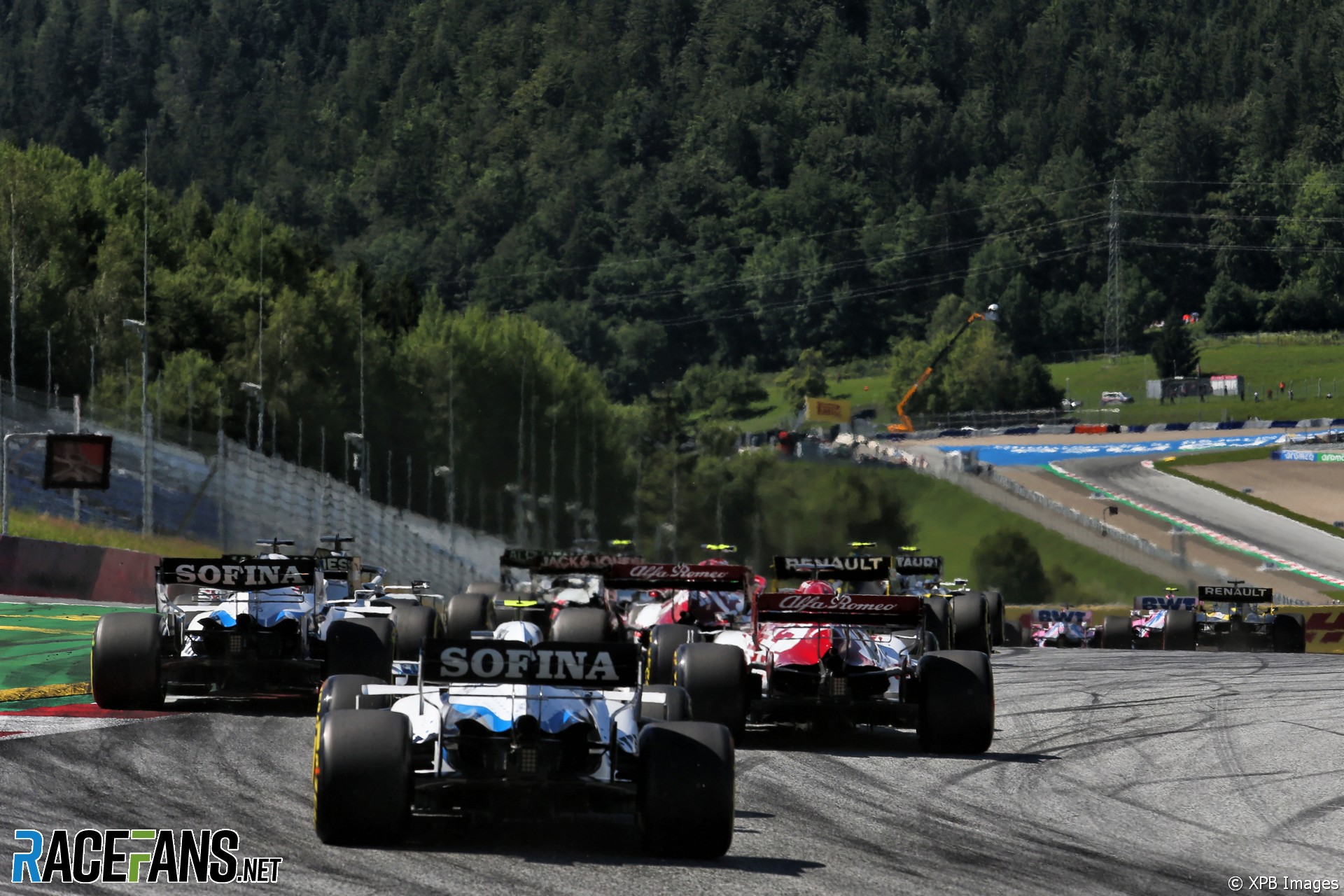In the round-up: Nicholas Latifi says he’s surprised how severe the effect of ‘dirty air’ is in F1 cars.
What they say
Latifi was asked how far becoming an F1 driver matched up to his expectations:There’s a bit two sides to look at it. When I signed with Williams last year, I was very well aware that I wasn’t going to be in a top car and a top team and experiencing the same kind of racing that I was in the previous year, racing up at the front in Formula 2. But that’s part of it. So my expectation. my mind was already prepared for that.
So at that point of view, it is quite different. There’s many, many other things you have to manage, the blue flags and things like that, which do change it quite a bit.
But if you take out the performance of the car, just the actual experience of racing, it is quite a lot different than honestly I expected it to be. The dirty air effect at the start of the race, just the amount of grip you you lose, is far more that I could have ever imagined. It’s been difficult to explain it to someone unless they could actually experience it.
So from that point of view I still say it’s more fun than I initially thought it was going to be just from how lively everything is at the start, the racing action, how much quicker you have to be to react to certain things in racing actions. I’m still learning how to deal with those things.
Quotes: Dieter Rencken
Advert | Become a RaceFans supporter and
Social media
Notable posts from Twitter, Instagram and more:
Lando loves lockdown life.
Budapest restrictions for British visitors don't bother the McLaren driver.
(He later added: "I didn't say I eat burgers, specifically! A bit of pizza sometimes…")#F1 #HungarianGP pic.twitter.com/XhulOrri5W
— RaceFans (@racefansdotnet) July 16, 2020
I go to Eindhoven for a meeting and what do I see parked up at a charging point but the clearest indicator yet that the city is angling for @FIAFormulaE round… pic.twitter.com/upoxIWsdr4
— Fritz-Dieter Rencken (@RacingLines) July 15, 2020
- Find more official F1 accounts to follow in the F1 Twitter Directory
Links
More motor racing links of interest:
"I think Lewis has been a great example to an awful lot of people. He's a wonderful driver, he's got an enormous number of victories behind him and he's quite vocal about all these elements. I don't think there's as big a problem in that as there might be seen. For example Cranfield university in England starting having women get more interest in engineering and motorsport. Now suddenly we've got a huge number of women in Formula 1 because they've gone to good universities and been well educated, etc... In Lewis's case, the colour issue he refers to can change very rapidly. There's no resistance to change in Formula 1."
'Digital has become the free-to-air platform' F1’s Frank Arthofer (Sport Business)
"We’ve almost quadrupled our social media followers since the beginning of 2017, and that’s almost entirely through organic social growth. We’ve doubled our video views each year, we’ve doubled the page views of F1.com and of our app each year. Equally, the market is changing, so I think the move to pay-TV in 2020 is different than the move to pay-TV might have been in 2005."
Berger admits DTM may need to be ‘wound up’ after 2020 (Motorsport)
"To put it in a nutshell, the time has come to think about winding-up the DTM. If none of the German manufacturers are willing to support this platform and series anymore, things will get tight."
Jean Todt za HRT: Viđam Schumachera i dalje, kad god mogu (HRT)
FIA president Jean Todt describes howw he still visits Schumacher regularly.
Behind the lens with BT Sport Moto GP as racing resumes (Motorsport Broadcasting)
"Not being in the paddock is always going to be a disadvantage, however Dorna have been brilliant throughout. They understand that we’re not going to be travelling and they’ve done their best to help us with that."
How the Hungaroring has changed (RaceFans via YouTube)
We always endeavour to credit original sources. If you have a tip for a link to feature in the next RaceFans round-up please send it in via the contact form.
Advert | Become a RaceFans supporter and
Comment of the day
Formula 1 should be relying on electronics to police track limits, says Gavin:
I’m still perplexed why they don’t stick a metre of gravel/grass on the outside of the kerb. After that you can have loads of Tarmac run off till the physical barrier if required. This keeps the track the same size – this ‘allowable’ run off has increased the speeds through corners which impacts run off in the next corner and so on and so on.
Also the length or tarmac run off in places is also perplexing – the most ridiculous example of this I can think of is they Tarmac-ed the small grass run off on the exit of the hairpin in Canada. The exit! There’s probably a top speed there of about 30mph if that.
Adding this small strip of ‘classic’ run off creates a sporting penalty for running wide which is our main complaint about tarmac run offs. No fan wants to see people get hurt (be they drivers, marshals or fans) but we want to see drivers taking risk versus reward, overtakes (not just DRS motorway passes – bully a driver into mistakes!) and proving who has the skill required to pilot these things.
Gavin Campbell
Happy birthday!
Happy birthday to Bradley13 and David Hoops!
If you want a birthday shout-out tell us when yours is via the contact form or adding to the list here.






Dan
17th July 2020, 0:43
“Formula 1 should be relying on electronics to police track limits, says Gavin”
Seems like that should be, “shouldn’t”?
Mog
17th July 2020, 5:25
Thank you Jackie Stewart. There is no resistance to change, hence no need to bully others on an issue that all are addressing as well as they can.
ian dearing
17th July 2020, 8:43
Not according to Sky; who pretty much rule the F1 airwaves. They regularly cite other sports as doing a far better job. Noting that the Sky message is-BLM; not end racism. Anyone who watched last weekend will see they berated Carey, Ham and Wolff for each not doing enough. Although some may question Sky’s motives behind this.
And it sounds from Stewart with his reference to Cranfield that Hamilton is taking the right route with his commission by engaging with the Royal Academy of Engineers to lead the study. Although I would take issue with Stewarts statement about ‘huge numbers’ when we are discussing women (engineers) within F1.
mirko710
17th July 2020, 7:41
that croatian in the title caught me a little off guard. Maybe I need more coffee or browser went beserk again.
I was at Hungarian GP 2011. Closest option from Croatia before Styrian GP returned.
That was an interesting race, I remember the sonic wall rattling me at the start, we were at the last corner stand.
I came back in 2015 to check a Friday free practice. Testing a new mobile ‘handy’ and discovering later that it took stills, not video… so if anybody needs a dozen shots of an empty track tarmac :p
GP2 4liter V8s engines sounded great compared to then gen new hybro-turbo power units.
Jere (@jerejj)
17th July 2020, 7:52
Regarding the COTD: In my view, this thing about electronically policing track limits has gone overboard, so they should do away with it. Not every brief off-track excursion automatically has an impact on the overall lap and or sector time, so it shouldn’t be done only for the sake of it. Having those at the exit of high to medium-speed corners I can still understand as those are the ones where an off-track excursion has a realistic possibility of having a direct impact on the overall time, but Hungaroring’s T12 is as slow-speed one, so why also there?
I have an opinion
17th July 2020, 8:00
Latifi has nineteen cars’ worth of dirty air to contend with.
ColdFly (@)
17th July 2020, 8:44
I agree with the CotD that sage natural impediments are better than the current electronic loops.
But if they go electronic then go the whole way; don’t stop at measuring and then send it to people to analyse and decide.
Maybe if the track limit loop triggers the onboard sensor then automatically reduce power by 50BHP for 1-2s. In other words a bit like the direct impact you get when hitting a grass runoff.
Jere (@jerejj)
17th July 2020, 9:19
@coldfly A sudden loss of speed could be risky for the driver(s) just behind around the corner.
ColdFly (@)
17th July 2020, 12:41
@jerejj, taking away 50BHP would be less of an impact than hitting a patch of grass (lifting and/or wheel spinning)
mirko710
17th July 2020, 10:39
maybe disable electric boost for a next lap. warning lights to inform drivers behind, similar to recharging
or what @didaho said in -vvv- comment under
HAL
17th July 2020, 16:15
If we are to keep these electronic sensor thing, I think it’s a very good idea.
Duncan Idaho (@didaho)
17th July 2020, 9:34
Do the reduction immediately in qually and on the next straight during a race.
socksolid (@socksolid)
17th July 2020, 10:36
I like the idea of electric track limits but it doesn’t really fix the actual problem. The stewards. No matter how the track limits are checked there is always stewards who make the last decision on it. If it was a last lap pass or a top team driver running wide during the race they’ll never act on it. See leclerc vs hamilton in monza. It was a clear cut penalty but because who it was and when it was there was never going to be a penalty. That evidence can be video, electronic sensors, telemetry or whatever. If the stewards don’t want to give a penalty there won’t be a penalty no matter how many different clear cases of evidence you have.
GT Racer (@gt-racer)
17th July 2020, 12:17
I was once told that the reason they don’t do that is because of the risk of that a strip of gravel could cause a car to get a bit of air & jump/skip above any subsequent tarmac. Same with a strip of grass which could become uneven & also cause a car to be launched.
Think something like what happened with Mika Hakkinen at Adelaide in 1995. The car got a bit of air over the kerb & then bounced across the tarmac losing barely any speed before hitting the wall.
The belief (Based off data from various incidents over the years across multiple categories) is that having a flat tarmac surface offers the safest solution as there is no risk of cars been launched, flipping or bouncing. Cars staying on the ground from kerb to barrier offers the best opportunity to scrub of speed as well as ensuring the car impacts the barrier flat. If a car gets a bit of air in the runoff not only is the runoff not able to work effectively at slowing the car down but it also increases the possibility of cars impacting barriers in ways that makes them & the crash structures on the cars less effective.
And bear in mind this isn’t just in terms of F1, The runoffs/barriers have to be designed in a way that suits every category that uses them as well as any other activities a circuit promoter may use the circuit for outside of race weekends.